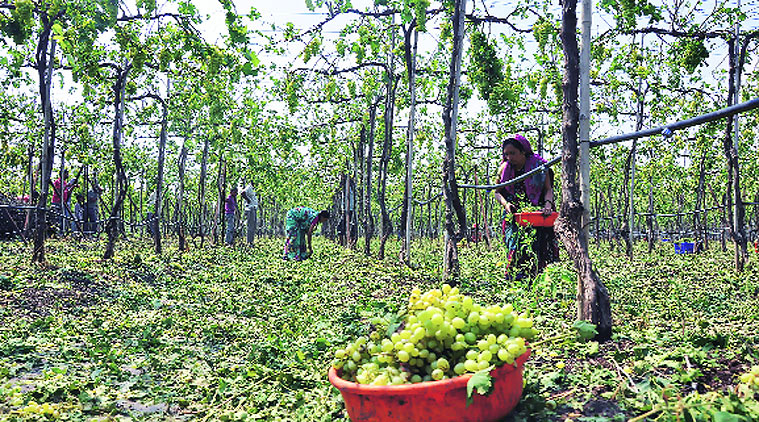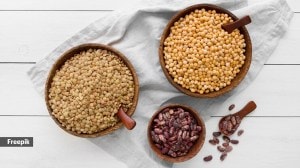- India
- International
The Failing Fields: From mango to sugar, it’s a bitter story
Farmers have the sudden rain in March to blame for the poor quality of harvest.
 Grapes destroyed by hailstorm in Nashik (Source: IE photo)
Grapes destroyed by hailstorm in Nashik (Source: IE photo)
Sweeter than the Gujarati Kesar. That is how Bhagwat Thombre describes his mangoes, citing a less popular contest between Maharashtra and Gujarat, but one that he claims mango connoisseurs know well. A mango grower since 1988, Thombre’s success story from his five acres of dryland in Undhri village, 25 kilometres from the Kaij taluka headquarters in Marathwada’s Beed district, ended earlier this month: Undhri’s most successful mango farmer has “zero output” this year.
Also Read: Wheat crop damaged, only seeds of discord at Punjab’s mega mandi
“I started Undhri’s first mango farm. Of 4,000 acres in Undhri, we have 500 acres of mango trees. The fruits were ready for harvest, thousands of them, more than I have seen in many years. But after the hailstorm, most of the fruits fell, the remaining have spots and holes. I’m giving them away for any price that local families are offering,” says Thombre, adding that his losses run into several lakhs.
[related-post]
Till last year, he was packing his fruit “in boxes like the Alphonso packaging” and getting Rs 200 per kg. “This year, 90 per cent of my mangoes just rotted in my field as the rain continued,” he says.
Thombre’s tale is mirrored by similar narratives across the state. From wheat, gram, bajra and jowar farmers across the state to horticulturists in north Maharashtra and Marathwada, from vegetable cultivators to dairy farmers in western Maharashtra, farm distress in the state this year has set the stage for rising migration, alongside reports of suicides.

For Maharashtra’s beleaguered farm sector, crippled by two drought years (2012 and 2014) and recurrent hailstorms and unseasonal rainfall, the latest blow came as recently as earlier this month when a fresh hailstorm destroyed standing crop including, cruelly, some ready for harvest.
Some parts of Beed district saw rain on Tuesday too, but the impact was minimal. “There’s nothing left in the fields to be destroyed,” says Bagruwan Kanse, a farmer in Beed who lost his crop to the hailstorm this month.
Based on reports, until Tuesday, at least 45,000 hectares of crop, mostly standing crop, had been severely damaged by the unseasonal rainfall and hailstorm since April 4. While 1.12 lakh hectares of crop were damaged in the March 8-15 rain and hail, 1.29 lakh hectares were affected in the February 28-March 3 period.
While data on the crops that have been worst hit by this month’s bad weather is still being compiled, the hailstorms and rain of February and March dealt a body blow to wheat and gram. Jowar, already hit by the kharif season drought and the poor sowing percentages for rabi jowar, sustained further damage. Among the horticulture crops, grapes in north Maharashtra and pomegranate and mango in Marathwada are worst hit.
This is in addition to the extensive damage to crops, including wheat, bajra and jowar, as well as to horticulture in November-December 2014, when as much as 52,993.73 hectares of crop were damaged by the hailstorms and rain.
North Maharashtra suffered the maximum damage then, with the fertile Nashik division accounting for 42,260 hectares of damaged crop. As many as 1,00,675 farmers in Nashik division (Nashik, Dhule, Jalgaon, Ahmednagar, Nandurbar districts) were affected, including 76,840 farmers in Nashik district alone.
Late last year, the government, then barely a couple of months in office, announced a relief package for hailstorm-hit farmers, with a little over Rs 86 crore disbursed. Relief for this year’s rain and hail damage is yet to be announced.
Farm distress bailouts are fast becoming a headache for the Devendra Fadnavis government.
With agricultural drought declared in over 24,000 villages (including all the 8,000-odd villages in Marathwada), over 60 lakh farmers availed government dole for a failed kharif crop this year, with Rs 3,433.49 crore disbursed till last week. Of 147.24 lakh hectares sown in the kharif season, 109.54 lakh hectares were affected by drought-related crop damage. The rabi season’s final data is expected to be worse, with the arid Marathwada districts reporting a 40 per cent decline in sowing.
At the other end of the spectrum, the powerful sugar industry is seeking a bailout as well. The crisis in the sugar industry is on account of a global glut. A 15 per cent increase in production across India (2014-15), plus Maharashtra’s own bumper crop, have sent prices crashing. Maharashtra’s sugarcane factories, the bulk of them in the western districts, have produced 9.96 million tonnes of sugar this year, up from 7.44 million tonnes last year. The nearly 10 million tonnes is a record for the state.
The 200 sugar mills across Maharashtra have multiple problems — falling prices of sugar that have dipped from nearly Rs 2,700 a quintal to Rs 2,100 a quintal, unpaid cane price arrears, lowered credit from cooperative banks. The industry made a pitch for a Rs 4,500-crore package, backed by the Nationalist Congress Party, but that was turned down by the government though some other policy measures were announced.
Poor prices have also hit vegetable farmers, with the onion market being the worst hit.
In Umrana village ahead of Nashik, where a quintal of onion was sold by farmers for Rs 1,500 until early April, prices have now fallen to Rs 1,000 per quintal. Mahadeo Dhuge, an onion trader, says, “The grade of onion has degraded from ‘A’ to ‘C’. The quantity too has declined due to rain.”
Farmers have the sudden rain in March to blame for the poor quality of harvest. Girdhari Rao, a farmer with 8 acres of land in Saundana village, usually produces 200 quintals of onion in a season. “This time, the good quality onions were just 70 quintals,” he says. Rao adds that several farmers have been returning from their markets with unsold stock.
The story of cotton prices in Maharashtra is similar, as it is for milk. Dairy farmers in the state are getting an average of Rs 20 a litre for cow milk , down by almost 50 per cent from last year’s prices.
While the onion traders of Lasalgaon have been insisting on policy changes to push exports further, horticulture exports could be hit by up to 50 per cent, estimate farmers.
Appasaheb Tikhe of Surdi Sonsanghvi in Kaij, twin villages that shunned sugarcane in the mid-1990s to opt for watermelon, lost 15 acres of watermelon due to the April hailstorm. “Our village has specialised in watermelon,” he says. “And this year each of our 60 to 65 farmers will be deep in debt.” Watermelon from the 450 acres in Surdi Sonsanghvi will not make it to suburban Mumbai’s Vashi market this year.
Similarly, while the Kesar mango of Beed, Latur and Jalna districts met export quality criteria and was despatched to Germany and Saudi Arabia in recent years, farmers say there will barely be enough for the local markets this year.
Marathwada is home to about 7,500 hectares of Kesar mango orchards, whose output is expected to be hit by up to 70 per cent. Pomegranate exports from Marathwada are expected to be zero as well. Farmers who made an average profit of Rs 5 lakh a year from pomegranate cultivation, suitable for dryland farming where assurance of water is nearly zero, are now hoping to get government dole as well.
Apr 25: Latest News
- 01
- 02
- 03
- 04
- 05








































